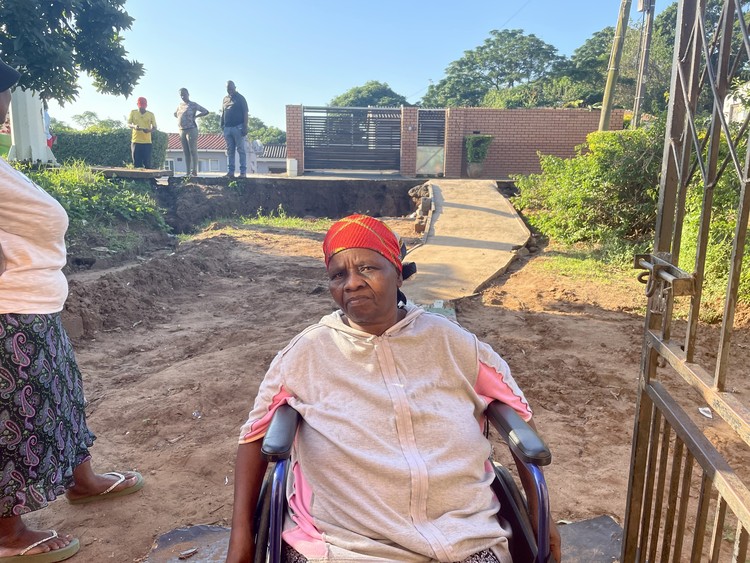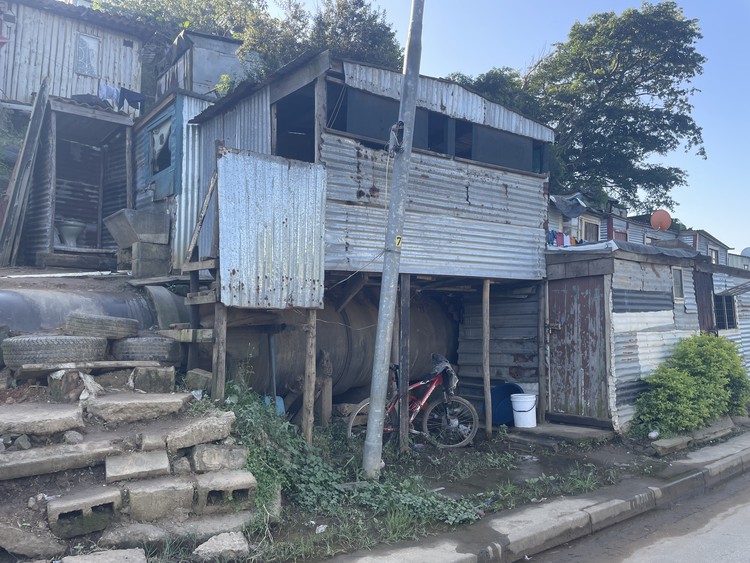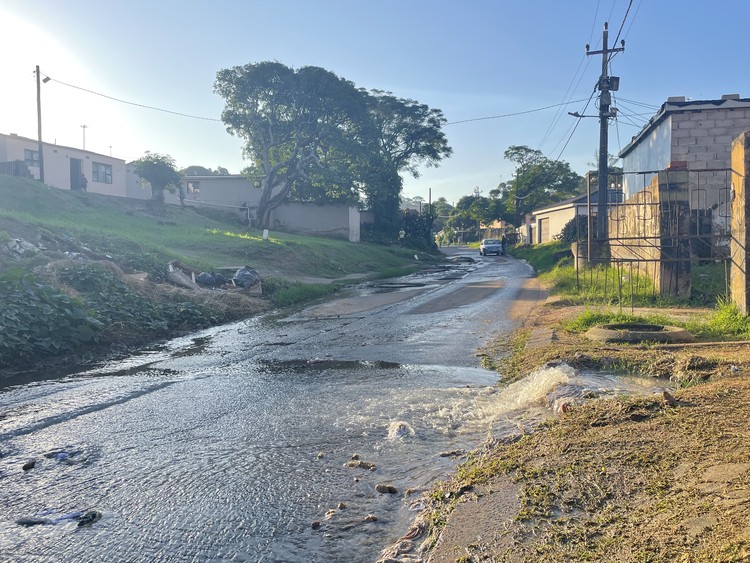Sewage floods the streets in this part of Durban
Lamontville has been battered by floods
Busisiwe Nzama in front of a ramp built for her by community members so that she can reach the road. Photos: Joseph Bracken
The community of Lamontville, south of Durban, has experienced flooding at least once a year since 2021, damaging houses and washing away roads. When heavy rains come, sewage bubbles up from the ageing pipes and fills the streets.
When GroundUp visited the area in early May, residents told us that they believe much of the damage to their homes could have been prevented by proper drainage in the area.
The home of Busisiwe Nzama, a disabled pensioner and Lamontville resident, is flooded at least once a year, she says. There is no proper drainage on the road outside her home, so the water flows straight into her home, she says.
A large portion of the road’s embankment has washed away, creating a steep drop-off. To get to the road, Nzama, who uses a wheelchair, needs assistance from family members to push her up a makeshift ramp, built for her by her neighbours.
Further upstream from Gwala Street, also running adjacent to the Umlazi River, is Matwebula Road. Large parts of the road were originally torn apart in the 2022 floods, say residents.
eThekwini Municipality spokesperson Gugu Sisilane told GroundUp that the damaged roads must be fixed by the municipality’s roads and engineering department, but the water and sanitation department will first have to address sewage leaks and storm drain issues.
That department is currently in the process of identifying faults and resolving them, she said.
A bathroom built by residents on top of the sewage line.
Sewage overflow
Flooding has made sewage spills, already prevalent in the area, much worse, residents say.
Along the Umlazi River, a large sewage pipe cuts through Lamontville. In some parts, people have built outhouses directly on the pipe by cutting large holes and placing toilets on top. When it rains, the sewage bubbles up through the holes and flows into the street and directly into the river.
Municipality spokesperson Sisilane said the tampering of sewer lines in any way is prohibited and should be reported to the municipality when discovered.
But even where pipes haven’t been tampered with, blockages often cause sewage spills. For more than a year, sewage has regularly poured out onto Mpanza Street, even when it isn’t raining, says community leader Bonga Sithole.
He says that when the municipality comes to fix the blockage, it only takes a few days for it to start overflowing again. The community consistently presses the councillors to fix these issues, but nothing improves, says Sithole.
Residents have cut holes into sewage pipes, installing toilets directly on the lines. When it floods, sewage bubbles over.
But Sisilane says the problem is being resolved. “Sanitation currently has a large project for the rehabilitation of the Umlaas Trunk Sewer Line and contributing lines, which will undertake the unblocking, pipe repairs and upgrade of sewer lines in Lamontville,” she said, but provided no deadline for the project.
She said the damage to the roads and sewage infrastructure is due to a combination of factors including misuse of the municipal networks, ageing infrastructure, delays in repairs and storms
Raw sewage spills into Mpanza street from a blocked pipe.
Relocating Flood Victims
In March, GroundUp reported that nearly 230 people from Lamontville had to be relocated by the municipality due to their homes being damaged or destroyed by the floods in February. They are temporarily being housed in two lodges in Durban.
Gwala Street, which sits next to the Umlazi River, was one of the severely affected areas. According to Khumba Gqwaru, who lives next to Gwala Street, the whole area floods whenever there is heavy rain due to its proximity to the river.
A hundred Temporary Relocation Units (TRUs) – prefab buildings meant to provide temporary accommodation – near Gwala Street were flooded in February. Over 40 units were destroyed and the families living there were relocated. The other units were repaired.
A location in Georgedale, about 50 km west of Lamontville, has been identified for the construction of another 100 TRU’s, says Sisilane. This is where displaced families from Lamontville, including those from Gwala Street, will be moved to.
Support independent journalism
Donate using Payfast

Don't miss out on the latest news
We respect your privacy, and promise we won't spam you.
Next: Hundreds of state mental health patients are being kept in prison
Previous: Global Fund is $6-billion short and may have to cut life-saving programmes
Letters
© 2025 GroundUp. This article is licensed under a Creative Commons Attribution-NoDerivatives 4.0 International License.
You may republish this article, so long as you credit the authors and GroundUp, and do not change the text. Please include a link back to the original article.
We put an invisible pixel in the article so that we can count traffic to republishers. All analytics tools are solely on our servers. We do not give our logs to any third party. Logs are deleted after two weeks. We do not use any IP address identifying information except to count regional traffic. We are solely interested in counting hits, not tracking users. If you republish, please do not delete the invisible pixel.




